2013 DACIA SANDERO air condition
[x] Cancel search: air conditionPage 42 of 146
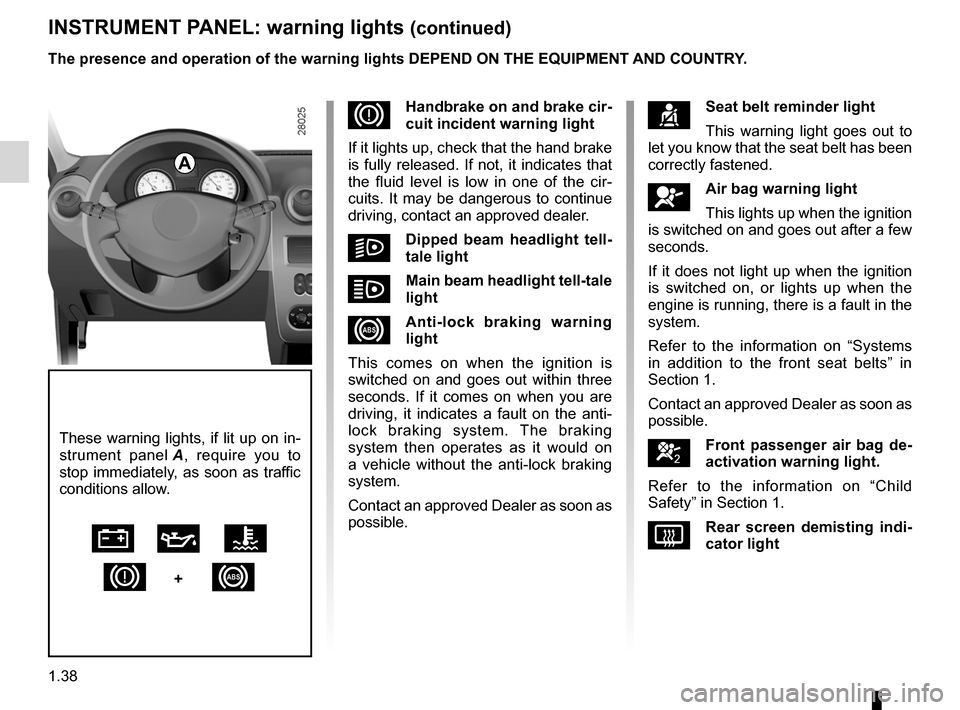
rear screendemisting .........................................................(current page)
1.38
ENG_UD5559_1tableau de bord : Témoins lumineux (B90 - Dacia)ENG_NU_817-2_NU_Dacia_1
INSTRUMENT PANEL: warning lights (continued)
The presence and operation of the warning lights DEPEND ON THE EQUIPMENT\
AND COUNTRY.
DHandbrake on and brake cir- cuit incident warning light
If it lights up, check that the hand brake is fully released. If not, it indicates that the fluid level is low in one of the cir- cuits. It may be dangerous to continue driving, contact an approved dealer.
mDipped beam headlight tell- tale light
oMain beam headlight tell-tale
light
xAnti-lock braking warning light
This comes on when the ignition is switched on and goes out within three seconds. If it comes on when you are driving, it indicates a fault on the anti- lock braking system. The braking system then operates as it would on a vehicle without the anti-lock braking system.
Contact an approved Dealer as soon as possible.
çSeat belt reminder light
This warning light goes out to let you know that the seat belt has been correctly fastened.
åAir bag warning light
This lights up when the ignition is switched on and goes out after a few seconds.
If it does not light up when the ignition
is switched on, or lights up when the engine is running, there is a fault in the system.
Refer to the information on “Systems in addition to the front seat belts” in Section 1.
Contact an approved Dealer as soon as possible.
]Front passenger air bag de- activation warning light.
Refer to the information on “Child Safety” in Section 1.
VRear screen demisting indi- cator light
These warning lights, if lit up on in-
strument panel A, require you to stop immediately, as soon as traffic conditions allow.
ÚÀÔ
D+x
A
Page 61 of 146

driving ...................................................(up to the end of the DU)starting ..................................................(up to the end of the DU)starting the engine ................................(up to the end of the DU)
2.3
ENG_UD5482_1Mise en route / Arrêt du moteur (U90 - Dacia)ENG_NU_817-2_NU_Dacia_2
Stopping the engine
With the engine idling, turn the key back to “Stop” position St.
ÉDiesel injection
Turn the ignition key to ignition “On” po- sition M, and hold this position until the preheating warning light goes out.
Turn the key to starter position D with- out depressing the accelerator pedal.
Release the key as soon as the engine starts.
Starting the engine
Special feature on vehicles equipped with an engine immobiliser system
In very cold conditions (temperatures below –20°C): so that it is easier to start the engine, switch on the ignition for several seconds before starting the engine.
Make sure the engine immobiliser is not activated. Refer to the information on the “Engine immobiliser” in Section 1.
Petrol injection
Engine warm or cold
– Turn the key to the start position
without depressing the accelera- tor.
– Release the key as soon as the
engine starts.
Mise en route / Arrêt du moteur
STARTING/STOPPING THE ENGINE
Never leave your vehicle with the keys inside when leaving a child (or \
animal) in the car, even for a short period.
The reason for this is that the child may endanger himself or others by starting the engine, activating equipment such
as the window winders for example, or locking the doors.
Risk of serious injury.
Never switch off the ignition before the vehicle has stopped completely. Once the engine has stopped, the brake servo, power assisted steering and passive safety equipment such as air bags wi\
ll no longer operate.
The steering is locked when the key is removed.
Page 62 of 146
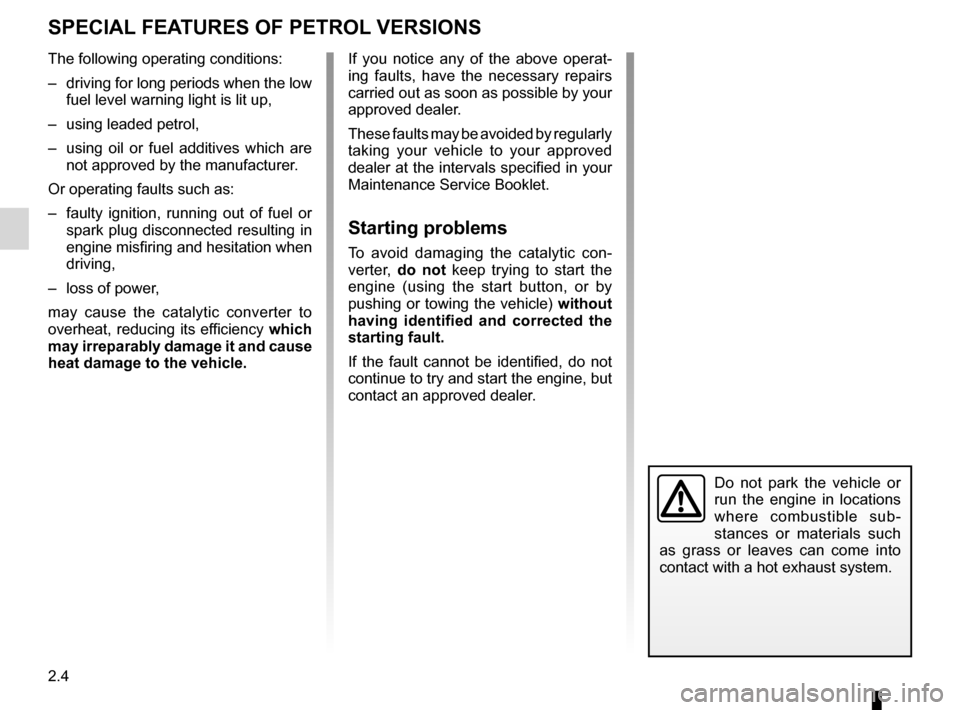
driving ...................................................(up to the end of the DU)catalytic converter.................................(up to the end of the DU)catalytic converter.................................(up to the end of the DU)special features of petrol vehicles ........(up to the end of the DU)
2.4
ENG_UD5483_1Particularités des versions essence (U90 - Dacia)ENG_NU_817-2_NU_Dacia_2
Particularités des versions essence
SPECIAL FEATURES OF PETROL VERSIONS
The following operating conditions:
– driving for long periods when the low
fuel level warning light is lit up,
– using leaded petrol,
– using oil or fuel additives which are
not approved by the manufacturer.
Or operating faults such as:
– faulty ignition, running out of fuel or
spark plug disconnected resulting in engine misfiring and hesitation when driving,
– loss of power,
may cause the catalytic converter to overheat, reducing its efficiency which may irreparably damage it and cause heat damage to the vehicle.
If you notice any of the above operat- ing faults, have the necessary repairs carried out as soon as possible by your approved dealer.
These faults may be avoided by regularly taking your vehicle to your approved dealer at the intervals specified in your Maintenance Service Booklet.
Starting problems
To avoid damaging the catalytic con- verter, do not keep trying to start the engine (using the start button, or by pushing or towing the vehicle) without having identified and corrected the starting fault.
If the fault cannot be identified, do not continue to try and start the engine, but contact an approved dealer.
Do not park the vehicle or
run the engine in locations where combustible sub- stances or materials such as grass or leaves can come into contact with a hot exhaust system.
Page 66 of 146

2.8
ENG_UD5485_1Conseils antipollution, économies de carburant, conduite (U90 - Daci\
a)ENG_NU_817-2_NU_Dacia_2
ADVICE ON ANTIPOLLUTION, FUEL ECONOMY AND DRIVING (continued)
– In vehicles fitted with air condi- tioning, it is normal to observe an increase in fuel consumption (es- pecially in city conditions) when it is used. For vehicles fitted with manual air conditioning, switch off the system when it is not required.
Some advice for reducing fuel consumption and therefore help- ing to protect the environment:
– It is advisable to drive with the air
vents open and the windows closed.
– If the vehicle has been parked in the
sun, open the doors for a few mo- ments to let the hot air escape before starting the engine.
– Never fill the fuel tank to the brim to
avoid overflow.
– Do not leave an empty roof rack
fitted to the vehicle.
– It is better to fit a trailer for bulky ob
- jects.
– When towing a caravan, fit a wind
deflector and adjust it carefully.
Advice on use
– Electricity is fuel; switch off all the electrical components which are not really needed.
However (safety first), keep your lights on when the visibility is bad (“see and be seen”).
– Use the air vents. Driving with the
windows open will increase fuel consumption by 4% at a speed of 60 mph (100 km/h). –
Avoid using the vehicle for door-to
- door journeys (short journeys, with long stops in-between) because in these conditions, the engine never reaches its ideal temperature.
Tyres
Increased fuel consumption could be the result of:
– insufficient pressure,
– using non-recommended tyres.
Page 71 of 146

3.1
ENG_UD8703_2Sommaire 3 (B90 - Dacia)ENG_NU_817-2_NU_Dacia_3
Section 3: Your comfort
Air vents. . . . . . . . . . . . . . . . . . . . . . . . . . . . . . . . . . . . \
. . . . . . . . . . . . . . . . . . . . . . . . . . . . . . . . . . . 3.2
Heating - Ventilation - Air conditioning . . . . . . . . . . . . . . . . . . . . . . . . . . . . . . . . . . . . \
. . . . . . . . . . . . 3.4
Interior lighting . . . . . . . . . . . . . . . . . . . . . . . . . . . . . . . . . . . . \
. . . . . . . . . . . . . . . . . . . . . . . . . . . . . . 3.9
Electric windows . . . . . . . . . . . . . . . . . . . . . . . . . . . . . . . . . . . .\
. . . . . . . . . . . . . . . . . . . . . . . . . . . . 3.10
Ashtrays/Cigar lighter . . . . . . . . . . . . . . . . . . . . . . . . . . . . . . . . . . . .\
. . . . . . . . . . . . . . . . . . . . . . . . 3.12
Storage compartments - Fittings . . . . . . . . . . . . . . . . . . . . . . . . . . . . . . . . . . . . \
. . . . . . . . . . . . . . . . 3.13
Luggage compartment - Transporting objects in the luggage compartment . . . . . . . . . . . . . . . . . . . 3.16
Rear parcel shelf . . . . . . . . . . . . . . . . . . . . . . . . . . . . . . . . . . . . \
. . . . . . . . . . . . . . . . . . . . . . . . . . . . 3.17
Page 72 of 146
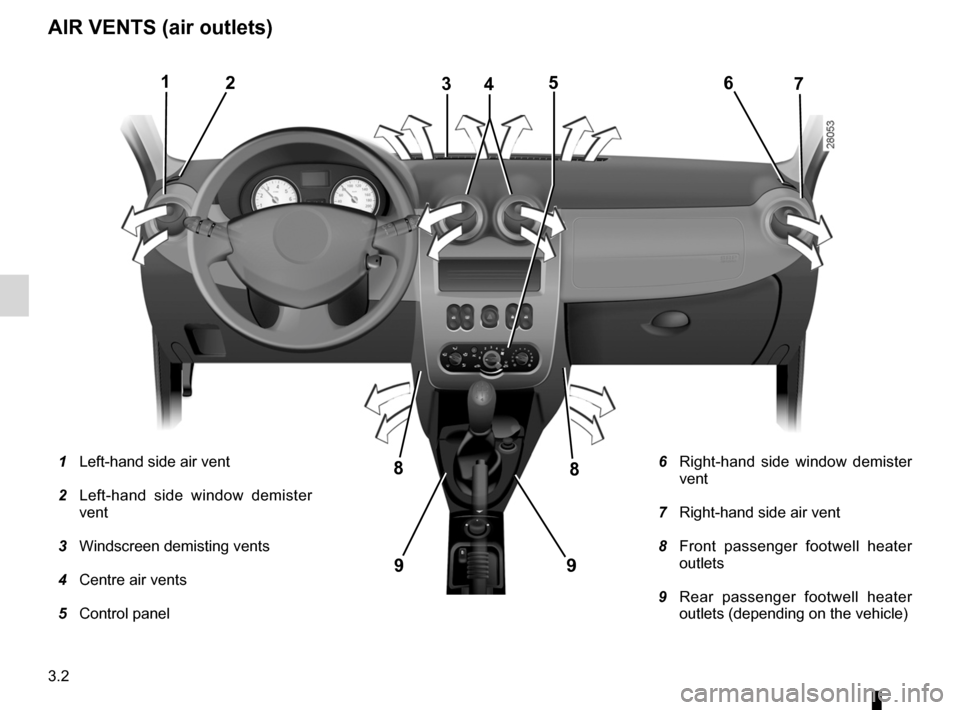
air vents ................................................(up to the end of the DU)heating system .....................................(up to the end of the DU)heating and air conditioning system .....(up to the end of the DU)
3.2
ENG_UD5579_1Aérateurs (sorties air) (B90 - Dacia)ENG_NU_817-2_NU_Dacia_3
JauneNoirNoir texte
Aérateurs
AIR VENTS (air outlets)
12367
1 Left-hand side air vent
2 Left-hand side window demister vent
3 Windscreen demisting vents
4 Centre air vents
5 Control panel
6 Right-hand side window demister vent
7 Right-hand side air vent
8 Front passenger footwell heater outlets
9 Rear passenger footwell heater outlets (depending on the vehicle)
54
88
99
Page 74 of 146
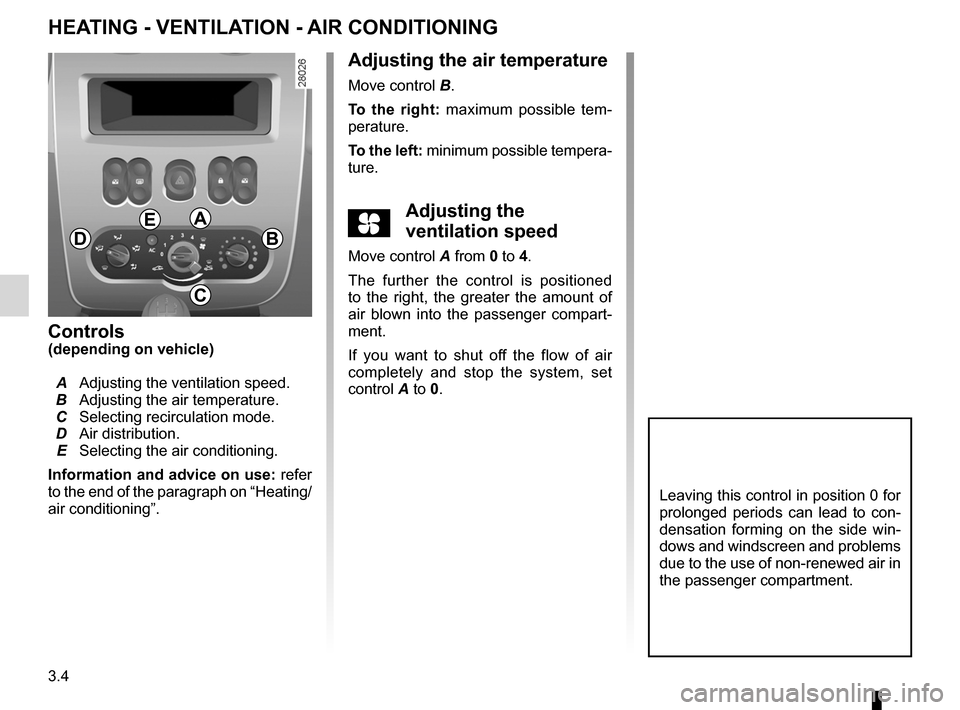
air conditioning .....................................(up to the end of the DU)heating and air conditioning system .....(up to the end of the DU)heating system .....................................(up to the end of the DU)ventilationheating and air conditioning system (up to the end of the DU)air conditioning .....................................(up to the end of the DU)
3.4
ENG_UD5580_1Chauffage - Ventilation - Air conditionné (B90 - Dacia)ENG_NU_817-2_NU_Dacia_3
JauneNoirNoir texte
Chauffage - Ventilation - Air conditionné
HEATING - VENTILATION - AIR CONDITIONING
Controls(depending on vehicle)
A Adjusting the ventilation speed. B Adjusting the air temperature. C Selecting recirculation mode. D Air distribution. E Selecting the air conditioning.
Information and advice on use: refer to the end of the paragraph on “Heating/ air conditioning”.
Adjusting the air temperature
Move control B.
To the right: maximum possible tem- perature.
To the left: minimum possible tempera- ture.
yAdjusting the
ventilation speed
Move control A from 0 to 4.
The further the control is positioned to the right, the greater the amount of air blown into the passenger compart- ment.
If you want to shut off the flow of air completely and stop the system, set
control A to 0.
Leaving this control in position 0 for prolonged periods can lead to con- densation forming on the side win- dows and windscreen and problems due to the use of non-renewed air in the passenger compartment.
D
EA
B
C
Page 75 of 146
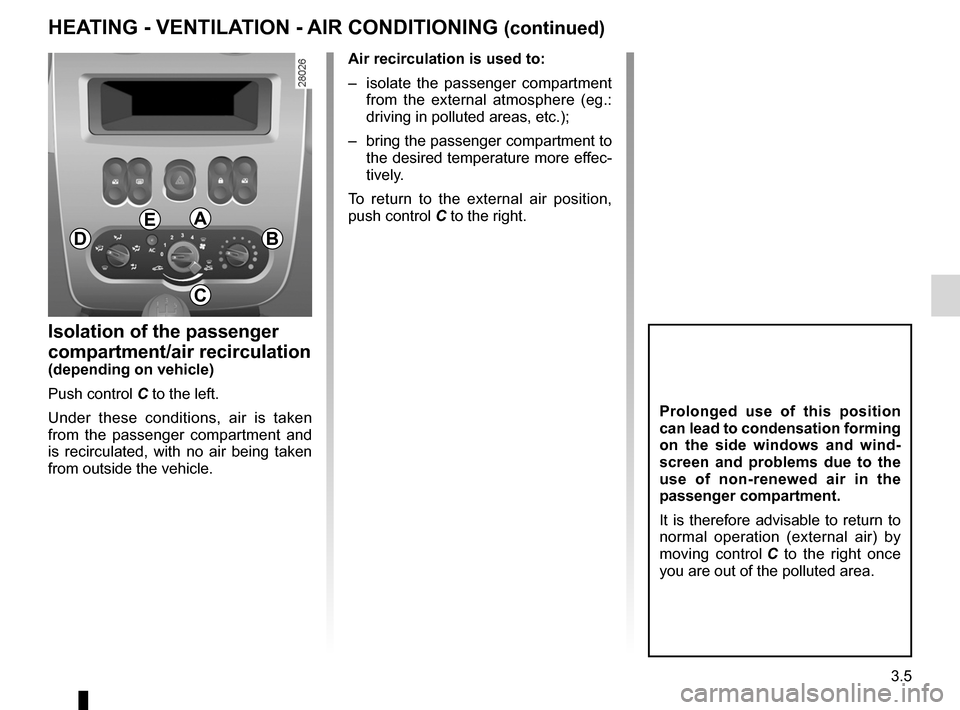
JauneNoirNoir texte
3.5
ENG_UD5580_1Chauffage - Ventilation - Air conditionné (B90 - Dacia)ENG_NU_817-2_NU_Dacia_3
HEATING - VENTILATION - AIR CONDITIONING (continued)
Isolation of the passenger
compartment/air recirculation(depending on vehicle)
Push control
C to the left.
Under these conditions, air is taken from the passenger compartment and is recirculated, with no air being taken from outside the vehicle.
Air recirculation is used to:
– isolate the passenger compartment
from the external atmosphere (eg.: driving in polluted areas, etc.);
– bring the passenger compartment to
the desired temperature more effec- tively.
To return to the external air position,
push control C to the right.
Prolonged use of this position can lead to condensation forming on the side windows and wind- screen and problems due to the use of non-renewed air in the passenger compartment.
It is therefore advisable to return to normal operation (external air) by
moving control C to the right once you are out of the polluted area.
D
EA
B
C